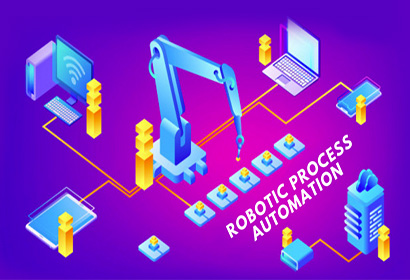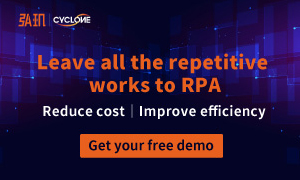What Is Robotic Process Automation And How To Use It
Meta Description:
Do you know what Robotic Process Automation is? Do you know how it works? Come and see this blog, you will know what you want!

What is Robotic Process Automation?
In the era of big data, digitalization has a greater impact on all walks of life. Faced with an unprecedented flood of information, people need the ability to process information quickly. And Robotic Process Automation is a tool that can help people get rid of repetitive work and improve efficiency.
What is RPA? Simply put, it can be understood as a "software robot". Just like those industrial robots and warehousing robots that automate production and transportation. However, it is not a real, visible robot, but a process automation service.
The basic tool RPA consists of a controller, an editor and a runner. At this stage, people can use RPA for data search, migration, input, and OCR can be recognized. At the same time, it can also filter statistics and organize verification of data.
How Does Robotic Process Automation (RPA) Work?
Although different RPA products work in different ways, their basic workflow is similar:
1. Process Mining
It generates a flowchart based on the log data from the business system. Then intuitively and objectively restore the actual business process.
2. Process Analysis
It will analyze the main KPI from the perspective of the process, and quickly locate the bottlenecks and pain points in the business process through the two dimensions of the process and the business by drilling and drilling analysis.
3. Process Conformance
It quickly identifies non-compliance and potential risks based on your customized standard process.
4. Process Simulation
It will use the digital twinning technology to simulate the results of process optimization, and quantify the impact of process optimization through the key KPI.
5. Process Optimization
It scientifically plans and submits process optimization requirements based on the bottlenecks, pain points, and prediction results revealed by the process analysis.
What are the characteristics of Robotic Process Automation?
1. Intelligent robot like human nature:
RPA belongs to the category of AI artificial intelligence, and the RPA simulates human actions to perform tasks through the design process. RPA works by simulating a human, operating on the system UI like a human, clicking the mouse, copying and pasting, opening files or performing data collection, etc. Because its core is the "analog man", it also puts pressure on the system, just as a person does normally on the system. So it does not have an excess load, and it will not have any adverse effects on the system.
For example, when you use RPA to collect data, it simulates the way people do their work. In this way, it will not cause a huge burden on the background like Crawler Tool work.
2. Strong automaticity:
Automated systems can read information on the screen and recognize key words or phrases. They can also understand basic commands and navigate through websites, applications and databases. RPA works well with repetitive tasks performed by employees who follow structured processes such as filling out forms or checking customer data against purchasing records.
For example, after an employee enters the details of a customer's bill into a spreadsheet using an Excel macro, the RPA enters that information into the application. The macro is programmed to recognize certain fields on each row: name, address, city/town etc., then copy these into the appropriate fields in a separate application such as Salesforce or QuickBooks Online. The benefit of this approach is that all information remains in one place so there's no need for double entry of data.
3. Low execution cost:
RPA robots can work 7*24 hours uninterrupted for a long time without human error, saving labor cost and time cost for the company. Moreover, business personnel do not need to be proficient in programming knowledge, as long as they are familiar with the operation in a short time, they can use RPA robots flexibly and familiarly. After a period of training, they can even design the RPA process themselves, leaving more time for value creation.
Next, I recommend an advanced RPA company for you: Cyclone
What’s The Differences Between Cyclone And Other Robotic Process Automation:
In Robotic Process Automation, once the workflow is automated and logic is configured in the system, you do not need to sit in front of a computer and configure some process wherever it is needed. Using Robotic Process Automation is globally acceptable as it doesn’t matter where the site or install changes. It’s gaining popularity day by day with wider usage of RPA tools.
Here's how Cyclone is different from other RPA company products:
1. Supports low-code or code-less operation:
The key capability of low-code is to template the functions of application scenarios and lower the threshold for application development. RPA can not only open up the underlying data and integrate data across systems, but also automate the replacement of repetitive operations by business personnel.
RPA itself has lower code properties. Some RPA products, such as Cyclone, do not require user familiarity with the code. And users can quickly build an "automatable process" by dragging and dropping. In some scenarios, they can even be used in combination to realize the vision of breaking the silos of information systems, rapidly iteratively responding to the rapidly changing external market environment, and improving internal productivity.
2. Strong scalability:
RPA robots can be deployed based on physical machines and virtual machines. In particular, Cyclone's robots also support the deployment and operation of different systems in different environments such as windows system, mac system, linux system, domestic system, and mobile terminal. When the enterprise needs it, it can expand the business scenarios and the number of robots at any time.
3. Security compliance:
RPA robots perform tasks based on clear business rules, which greatly improves the accuracy and compliance of business processing. At the same time, it also avoids possible errors in human processing. Users can comprehensively audit and trace RPA execution records based on logs, screenshots, and videos. And Cyclone also performed very well in this regard.
Conclusion:
In the digital age, time has become even more precious. And we need more efficient ways to deal with the competition from our peers. Start with RPA, and you'll understand how to best achieve success.





